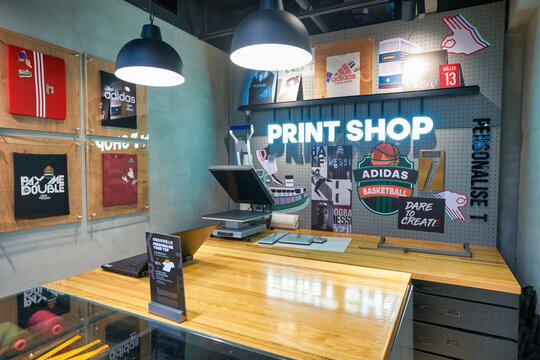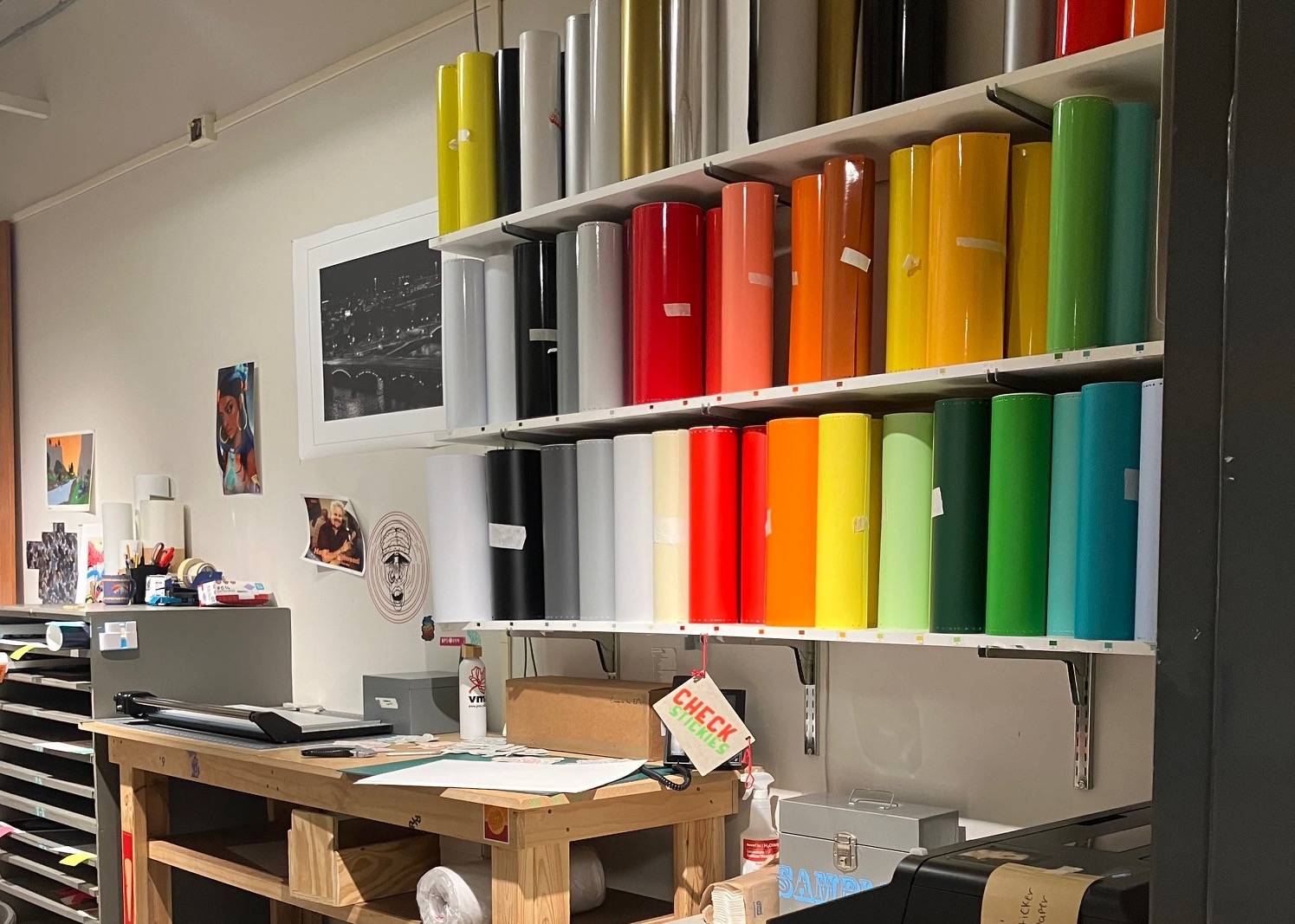Custom Framing Options to Ask About at a Print Shop Near Me
The Ultimate Overview to Utilizing Printing Solutions for Customized Art Prints
Steering through the globe of personalized art prints calls for a clear understanding of numerous printing solutions. Artists must consider variables such as printing methods and materials to accomplish the desired end result. Each decision, from art work prep work to color calibration, plays an essential function in the end product. As they discover these elements, artists can expose the capacity for their work to link with target markets in a significant means. What steps can they require to assure their prints attract attention?
Understanding Various Kinds Of Printing Services
Several individuals may ignore the details of printing services, comprehending the numerous types offered is crucial for anyone looking to produce custom-made art prints. One of the most common types include digital printing, counter printing, and display printing. Digital printing is favored for its quick turnaround and capability to generate premium photos straight from electronic documents, making it suitable for small runs. On the other hand, offset printing offers premium image top quality and is economical for larger amounts, making use of plates to move ink onto paper. Display printing, frequently utilized for fabrics and advertising things, involves pressing ink through a mesh display, permitting vibrant colors and textures. Each approach has its special benefits and restrictions, making it important for artists and developers to assess their particular needs, such as quantity, wanted top quality, and budget plan, before picking a printing solution that lines up with their artistic vision.
Picking the Right Products for Your Prints
Choosing the appropriate products is crucial for attaining high-grade custom-made art prints. Comprehending the various sorts of paper and the value of ink high quality can significantly impact the result. Musicians need to consider these variables to ensure their vision is accurately stood for in the printed item.
Paper Types Explained
Picking the best paper kind is necessary for achieving the wanted aesthetic and resilience in custom art prints. Numerous choices exist, each offering distinct attributes. Shiny paper enhances color vibrancy and detail, making it optimal for digital photography prints. On the other hand, matte paper provides a softer surface, which is better for artwork that needs nuance and structure. Fine art paper, frequently made from cotton or alpha cellulose, supplies historical top quality and appropriates for recreating complex information in paintings (Print Shop Near Me). Furthermore, specialized documents, such as watercolor or canvas, can add distinct aesthetic results. Ultimately, selecting the proper paper kind will greatly influence the last discussion, ensuring that the artwork is both long-lasting and visually attractive
Ink High Quality Issues
Ink quality plays a vital duty in the overall success of customized art prints. High-grade inks ensure lively shades, sharp information, and long life, which are vital for showcasing artistic work. When selecting printing services, artists must take into consideration pigment-based inks over dye-based options, as they offer better fade resistance and shade security. In addition, the selection of ink should complement the selected paper type, enhancing the print's visual impact. Environmental elements, such as humidity and temperature, can also affect ink efficiency; therefore, artists need to ask about ink formulas that resist these components. Inevitably, purchasing remarkable ink high quality can elevate the final product, assuring that the art print holds to the musician's vision for several years to find.
Checking Out Printing Techniques: Digital vs. Typical
While both electronic and conventional printing methods have their unique benefits, the decision on which approach to use typically hinges on the details requirements of the artwork. Digital printing masters adaptability and speed, enabling for quick turn-around times and the ability to publish as needed. This method is especially advantageous for musicians who require one-of-a-kind items or small runs, as it eliminates the requirement for considerable configuration processes.Conversely, conventional printing techniques, such as lithography and display printing, usually produce richer appearances and shades, attracting musicians seeking a more authentic and tactile surface. These methods can boost the deepness and quality of the artwork, making them suitable for bigger editions. In addition, conventional approaches may supply a distinct visual that digital printing occasionally battles to replicate. Eventually, the selection in between these techniques must take into consideration elements like preferred quality, quantity, and imaginative intent, guiding musicians to one of the most ideal choice for their projects.

Preparing Your Art Work for Printing
Successfully preparing artwork for printing needs cautious focus to information, despite the selected printing strategy. Musicians should ensure that their files are developed at the suitable resolution, usually 300 DPI, to maintain intensity and clarity. The correct shade mode, normally CMYK for print, is crucial to accomplish the wanted shade accuracy. Artists ought to likewise think about the measurements of the artwork, seeing to it to include bleed areas if required, to stop any kind of unwanted white edges after trimming.Additionally, file styles play a crucial duty; TIFF and PDF are typically favored for high-quality prints. Before submission, it is very important to her latest blog examine the art work for any kind of flaws or unwanted elements. By meticulously examining these facets, artists can enhance the possibility of their prints aligning with their creative vision, eventually resulting in an effective printing result.
The Value of Shade Calibration and Proofing
Color calibration and proofing are important action in the printing procedure, as they ensure that the final result precisely shows the artist's vision. Proper shade calibration assurances that the colors presented on the display suit those that will be published. This process involves readjusting the screen settings, printer accounts, and inks to achieve a regular shade representation.Additionally, proofing allows musicians to preview their job before the last print run. This stage allows them to find and remedy any type of inconsistencies in information, color, or saturation, therefore lessening costly mistakes. By using hard-copy or electronic proofs, musicians can make informed choices about changes needed for excellent results.Incorporating color calibration and proofing right into the printing operations not only boosts the quality of the last product yet likewise cultivates a reliable collaboration in between the artist and the printing service, assuring satisfaction and fidelity to the original artwork.
Choosing the Perfect Dimension and Style for Your Prints

Advertising and Marketing Your Custom-made Art Prints
Marketing and selling personalized art prints calls for a strong brand name have a peek at this website identity to stand out in an affordable market. Efficient on the internet promotion approaches and the strategic use social media systems can greatly enhance exposure and interaction. By integrating these elements, artists can create a compelling visibility that draws in potential purchasers.
Building Your Brand Identity
Developing a solid brand name identity is essential for artists wanting to successfully market and sell their custom art prints. This identity encompasses the artist's special design, worths, and tale, which resonate with potential purchasers. Musicians need to create a natural aesthetic presence across all systems, read this post here including logos, color pattern, and typography that show their artistic vision. In addition, a clear objective statement aids interact the musician's function and passion. Involving storytelling regarding the inspiration behind each item can cultivate emotional links with the audience. Uniformity in messaging, whether on social networks or packaging, boosts recognition and trust. By carefully curating their brand identification, artists can separate themselves in an open market, drawing in devoted consumers who value their virtuosity.
Reliable Online Promo Methods
What techniques can musicians utilize to properly advertise their customized art publishes online? Initially, developing an expert site showcasing the artwork is important. This site needs to include detailed descriptions and high-grade images to involve prospective purchasers. In addition, musicians can use e-mail marketing by constructing a customer checklist to share updates, promotions, and brand-new launches. Working together with bloggers and influencers in the art community can broaden reach and reliability. Providing special items or limited-time discounts can likewise create seriousness, motivating acquisitions. Enhancing content for search engines through pertinent keyword phrases will boost visibility. Maintaining a blog concerning the artistic process can draw in art enthusiasts, promoting a deeper link with the audience and improving the overall advertising and marketing approach.
Utilizing Social Media Site Operatings Systems
Social media systems work as powerful tools for musicians looking to market and sell their customized art prints. By leveraging systems like Instagram, Facebook, and Pinterest, musicians can showcase their work to a vast target market. Involving visuals and calculated hashtags can increase presence, attracting prospective buyers to their profiles. Frequently publishing content, such as new designs or behind the curtain processes, helps maintain target market interest and fosters a feeling of area. Additionally, artists can make use of targeted advertising and marketing to reach specific demographics, boosting the possibilities of sales. Cooperations with influencers or other artists can better intensify direct exposure. Ultimately, a well-curated social networks presence not just promotes customized art prints but also builds a dedicated consumer base gradually.
Regularly Asked Questions

Exactly how Do I Locate Dependable Printing Expert?
To find reliable printing company, one ought to research online testimonials, seek recommendations from peers, contrast portfolios, request samples, and analyze customer care responsiveness. This extensive approach warranties educated choices and sufficient end results.
What Is the Regular Turnaround Time for Customized Prints?
The normal turn-around time for custom prints varies by supplier, but normally ranges from a couple of days to two weeks. Variables affecting this include order size, complexity, and the details printing methods used.
Can I Obtain a Refund if I'm Not Completely satisfied With My Prints?
The question of acquiring a reimbursement for unsuitable prints usually depends upon the particular printing service's policies. Several companies supply contentment warranties, while others may have strict return conditions, highlighting the importance of examining terms in advance.
Exist Any Hidden Costs Connected With Printing Services?
Several printing solutions might consist of hidden prices such as arrangement costs, shipping costs, or additional costs for particular materials. It's essential for clients to ask about all potential expenditures before completing their order.
How Can I Guarantee My Prints Are Eco-friendly?
To assure prints are environmentally friendly, one should choose green inks, recycled paper, and lasting printing techniques. Investigating printing services that focus on sustainability and obtaining certifications can even more ensure marginal environmental impact in the printing procedure. Guiding with the globe of customized art prints calls for a clear understanding of numerous printing services. Many people may forget the details of printing services, comprehending the various kinds offered is crucial for any person looking to produce customized art prints. The most typical types include digital printing, balance out printing, and display printing. Successfully preparing art work for printing calls for mindful interest to detail, no matter of the selected printing strategy. Prints intended at galleries could require standard dimensions to assist in framework, whereas special styles might appeal to collectors looking for something distinctive.Lastly, the printing solution's capabilities have to be examined.